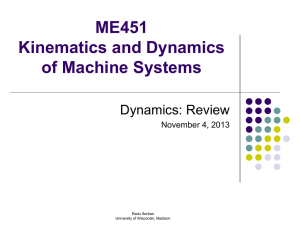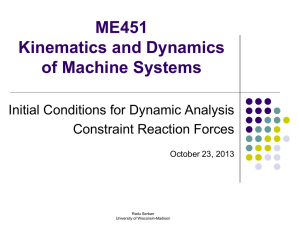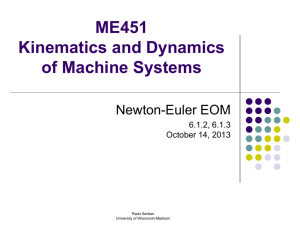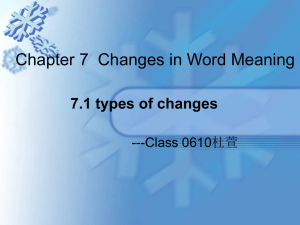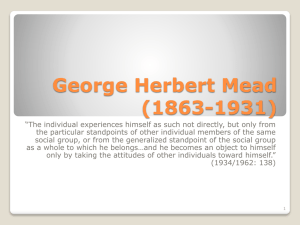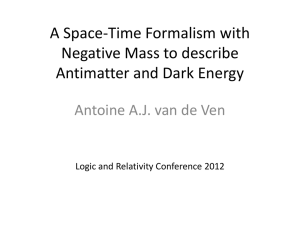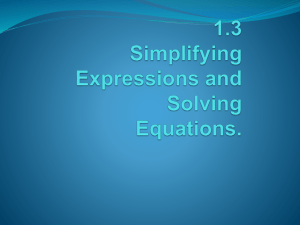ppt - SBEL - University of Wisconsin–Madison
advertisement
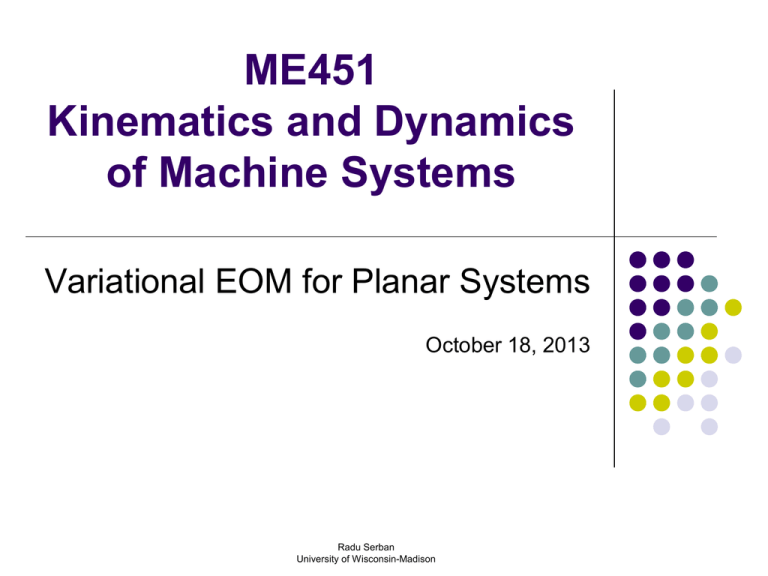
ME451 Kinematics and Dynamics of Machine Systems Variational EOM for Planar Systems October 18, 2013 Radu Serban University of Wisconsin-Madison Before we get started… Last Time: Today: Wrap-up generalized forces (TSDA & RSDA) Constrained variational EOM (variational EOM for a planar mechanism) Assignments: Properties of the polar moment of inertia Virtual Work and Generalized Forces Homework 8 – 6.2.1 – due Wednesday, October 23 (12:00pm) Matlab 6 and Adams 4 – due October 23, Learn@UW (11:59pm) Monday (October 21) lecture – simEngine2D discussion – in EH 2261 2 3 Roadmap: Check Progress What have we done so far? Derived the variational and differential EOM for a single rigid body These equations are general but they must include all forces applied on the body These equations assume their simplest form in a centroidal RF Properties of the polar moment of inertia What is left? Define a general methodology for including external forces, concentrated at a given point 𝑃 on the body Virtual work and generalized forces Elaborate on the nature of these concentrated forces. These can be: Models of common force elements (TSDA and RSDA) Reaction (constraint) forces, modeling the interaction with other bodies Derive the variational and differential EOM for systems of constrained bodies 6.2 Virtual Work and Generalized Force 5 Including Concentrated Forces or Torques Nomenclature: 𝐪 generalized accelerations 𝛿𝐪 generalized virtual displacements 𝐌 generalized mass matrix 𝐐 generalized forces Recipe for including a concentrated force in the EOM: Write the virtual work of the given force effect (force or torque) Express this virtual work in terms of the generalized virtual displacements Identify the generalized force Include the generalized force in the matrix form of the variational EOM 6 Including a Concentrated Force or Torque 7 (TSDA) Translational Spring-Damper-Actuator (1/2) Setup Compliant connection between points 𝑃𝑖 on body 𝑖 and 𝑃𝑗 on body 𝑗 In its most general form it can consist of: A spring with spring coefficient 𝑘 and free length 𝑙0 A damper with damping coefficient 𝑐 An actuator (hydraulic, electric, etc.) which applies a force ℎ(𝑙, 𝑙, 𝑡) The distance vector between points 𝑃𝑖 and 𝑃𝑗 is defined as and has a length of 8 (TSDA) Translational Spring-Damper-Actuator (2/2) General Strategy Write the virtual work produced by the force element in terms of an appropriate virtual displacement Note: positive 𝛿𝑙 separates the bodies where Hence the negative sign in the virtual work Note: tension defined as positive Express the virtual work in terms of the generalized virtual displacements 𝛿𝐪𝑖 and 𝛿𝐪𝑗 Identify the generalized forces (coefficients of 𝛿𝐪𝑖 and 𝛿𝐪𝑗 ) 9 (RSDA) Rotational Spring-Damper-Actuator (1/2) Setup Bodies 𝑖 and 𝑗 connected by a revolute joint at 𝑃 Torsional compliant connection at the common point 𝑃 In its most general form it can consist of: A torsional spring with spring coefficient 𝑘 and free angle 𝜃0 A torsional damper with damping coefficient 𝑐 An actuator (hydraulic, electric, etc.) which applies a torque ℎ(𝜃𝑖𝑗 , 𝜃𝑖𝑗 , 𝑡) The angle 𝜃𝑖𝑗 from 𝑥′𝑖 to 𝑥′𝑗 (positive counterclockwise) is 10 (RSDA) Rotational Spring-Damper-Actuator (2/2) General Strategy Write the virtual work produced by the force element in terms of an appropriate virtual displacement Note: positive 𝛿𝜃 𝑖𝑗 separates the axes where Hence the negative sign in the virtual work Note: tension defined as positive Express the virtual work in terms of the generalized virtual displacements 𝛿𝐪𝑖 and 𝛿𝐪𝑗 Identify the generalized forces (coefficients of 𝛿𝐪𝑖 and 𝛿𝐪𝑗 ) 11 Generalized Forces: Summary Question: How do we specify the terms 𝐅 and 𝑛 in the EOM? Answer: Recall where these terms come from… Integral manipulations (use rigid-body assumptions) Redefine in terms of generalized forces and virtual displacements Explicitly identify virtual work of generalized forces D’Alembert’s Principle effectively says that, upon including a new external force, the body’s generalized accelerations must change to preserve the balance of virtual work. Virtual work of generalized external forces As such, to include a new force (or torque), we are interested in the contribution of this force on the virtual work balance. Virtual work of generalized inertial forces 12 Roadmap: Check Progress What have we done so far? Derived the variational and differential EOM for a single rigid body Defined how to calculate inertial properties Defined a general strategy for including external forces Concentrated (point) forces Forces from compliant elements (TSDA and RSDA) What is left? Treatment of constraint forces Derive the variational and differential EOM for systems of constrained bodies 6.3.1 Variational Equations of Motion for Planar Systems 14 Variational and Differential EOM for a Single Rigid Body The variational EOM of a rigid body with a centroidal body-fixed reference frame were obtained as: Since 𝛿𝐫 and 𝛿𝜙 are arbitrary, using the orthogonality theorem, we get: Important: The above equations are valid only if all force effects have been accounted for! This includes both applied forces/torques and constraint forces/torques (from interactions with other bodies). 15 Matrix Form of the EOM for a Single Body Generalized Force; includes all forces acting on body 𝑖: This includes all applied forces and all reaction forces Generalized Virtual Displacement (arbitrary) Generalized Mass Matrix Generalized Accelerations 16 [Side Trip] A Vector-Vector Multiplication Trick Given two vectors 𝐚 and 𝐛, each made up of 𝑛𝑏 vectors, each of dimension 3 The dot product of 𝐚 and 𝐛 can be expressed as 17 Variational EOM for the Entire System (1/2) Consider a system made up of 𝑛𝑏 bodies Write the EOM (in matrix form) for each individual body Sum them up Express this dot product as 18 Variational EOM for the Entire System (2/2) Matrix form of the variational EOM for a system made up of 𝑛𝑏 bodies Generalized Virtual Displacement Generalized Force Generalized Mass Matrix Generalized Accelerations A Closer Look at Generalized Forces Total force acting on a body is sum of applied (external) and constraint (internal to the system) forces: Goal: get rid of the constraint forces 𝐐𝐶𝑖 which (at least for now) are unknown To do this, we need to compromise and give up something… 19 Constraint Forces Constraint Forces Forces that develop in the physical joints present in the system: (revolute, translational, distance constraint, etc.) They are the forces that ensure the satisfaction of the constraints (they are such that the motion stays compatible with the kinematic constraints) KEY OBSERVATION: The net virtual work produced by the constraint forces present in the system as a result of a set of consistent virtual displacements is zero Note that we have to account for the work of all reaction forces present in the system This is the same observation we used to eliminate the internal interaction forces when deriving the EOM for a single rigid body Therefore provided q is a consistent virtual displacement 20 Consistent Virtual Displacements What does it take for a virtual displacement to be consistent (with the set of constraints) at a given, fixed time 𝑡 ∗ ? Start with a consistent configuration 𝐪; i.e., a configuration that satisfies the constraint equations: A consistent virtual displacement 𝛿𝐪 is a virtual displacement which ensures that the configuration 𝐪 + 𝛿𝐪 is also consistent: Apply a Taylor series expansion and assume small variations: 21 22 Constrained Variational EOM Arbitrary Arbitrary Consistent We can eliminate the (unknown) constraint forces if we compromise to only consider virtual displacements that are consistent with the constraint equations Constrained Variational Equations of Motion Condition for consistent virtual displacements 6.3.2, 6.3.3 Lagrange Multipliers Mixed Differential-Algebraic Equations of Motion 24 [Side Trip] Lagrange Multiplier Theorem Joseph-Louis Lagrange (1736– 1813) Lagrange Multiplier Theorem: Example (1/2) 25 Lagrange Multiplier Theorem: Example (2/2) 26 27 Mixed Differential-Algebraic EOM (1/) Constrained Variational Equations of Motion Condition for consistent virtual displacements Lagrange Multiplier Form of the EOM 28 Lagrange Multiplier Form of the EOM Equations of Motion Position Constraint Equations Velocity Constraint Equations Acceleration Constraint Equations Most Important Slide in ME451 29 Mixed Differential-Algebraic EOM Combine the EOM and the Acceleration Equation to obtain a mixed system of differential-algebraic equations The constraint equations and velocity equation must also be satisfied Question: Under what conditions can we uniquely calculate the generalized accelerations and Lagrange multipliers? 30 Constrained Dynamic Existence Theorem 31 Slider-Crank Example (1/5) 32 Slider-Crank Example (2/5) 33 Slider-Crank Example (3/5) Constrained Variational Equations of Motion Condition for consistent virtual displacements 34 Slider-Crank Example (4/5) Lagrange Multiplier Form of the EOM Constraint Equations Acceleration Equation 35 Slider-Crank Example (5/5) Mixed Differential-Algebraic Equations of Motion Constraint Equations Velocity Equation
